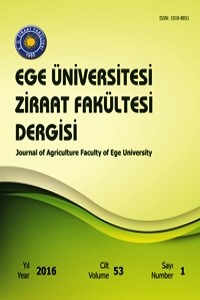Öz
The reducing role of public in economy had encouraged the private
alternatives in technology transfer, and also cost-sharing structures in
agricultural extension services. The structural changes vary according to the
country conditions. In this study, KOYMER Project, which was aimed at
decentralization, cost sharing and creating a pluralistic structure in Turkish
agricultural extension system, had been examined by interviewing with 566
consultants (advisors) in Turkey. Some
information on personal characteristics, activities and problems have been
gathered through the questionnaires. The project had positive effects on
extension workers–farmers ratios, behavioral changes in technical and
socio-cultural issues in rural areas. But, the planned financial contributions
of farmers and sustainability of the model predicted had not provided in the
project.
Anahtar Kelimeler
Kaynakça
- Anderson, J. R., Feder, G., 2003, Rural Extension Services, Worldbank Policy Research Working Paper 2976, 33 p.
- Axinn, G., 1988, Guide on Alternative Extension Approaches, FAO, Rome, Italy, 148p.
- Celik Ates, H., and Z. Gokce Cakal, 2014, Views of Extension Personnel on Extension Methods and Transition to Private Extension: The Case of Isparta Province, Journal of Agricultural Science and Technology, Vol:16 Supplementary Issue, 1529-1541pp.
- DPT, 2000, Tarimsal Politikalar ve Yapisal Duzenlemeler Ozel Ihtisas Komisyonu Raporu, DPT Sekizinci Bes Yillik Kalkinma Plani, DPT: 2516, OIK:534, Ankara 2000, 61s.
- Feder, G.,Willet, A., Zijp, W., 1999, Agricultural Extension Generic Challenges and Some Ingredients for Solutions, The World Bank Policy Research Working Paper 2129, Springer US, 313-353pp.
- Marcotte, P.,1988, Organizational behavior factors: a brief synopsis of leadership motivation and conflict management, Human Resource Management in National Agricultural Research: Report of a Workshop, ISNAR, The Netherlands, 168-182pp.
- Rivera, W. M., Qamar, M. K., Van Crowder, L, 2001, Agricultural and Rural Extension Worldwide: Options for Institutional Reform in the Developing Countries, Extension, Education and Communication Services, FAO, Rome, Italy, 49pp.
- Sigman, A., Swanson, B.E., 1993, Utilization of technology: the corner stone of agricultural development policy and programs, Agricultural Extension a Reference Manual, Second Edition, FAO, Rome, Italy. 227-231pp.
- Swanson B.E., Farner, B.J., Bahal, R., 1989, The current status of extension worldwide, Global Consultation on Agricultural Extension, FAO, Rome, Italy, 43-76pp.
- Swanson, B. E., Rajalahti, R. (2010). Strengthening agricultural extension and advisory systems: Procedures for assessing, transforming, and evaluating extension systems, The World Bank Agriculture and Rural Development Discussion Paper:45, Washington, DC.
- TEDGEM, 2007, http://www.tedgem.gov.tr/koymer.htm
- TEDGEM, 2009, http://www.tedgem.gov.tr/koymer.htm, access: 01.09.2009.
- TKB,2009,http://www.ordutarim.gov.tr/subeleler/cey/mevzuat/koymer.htm, access: 01.09.2009.
- TZOB, http://www.tzob.org.tr/tzob/tzob_ana_sayfa.htm
- ZMO, 2005, Proje Kapsamında Çalışan Ziraat Mühendisleri Kaderleriyle Baş Başa Kaldı, Tarım ve Mühendislik Dergisi, Sayı:75, Sayfa:42.
- TUIK, 2014, http://www.tuik.gov.tr, access:14.12.2014
Öz
Kamunun ekonomideki rolünün azalması, teknoloji |
Anahtar Kelimeler
Kaynakça
- Anderson, J. R., Feder, G., 2003, Rural Extension Services, Worldbank Policy Research Working Paper 2976, 33 p.
- Axinn, G., 1988, Guide on Alternative Extension Approaches, FAO, Rome, Italy, 148p.
- Celik Ates, H., and Z. Gokce Cakal, 2014, Views of Extension Personnel on Extension Methods and Transition to Private Extension: The Case of Isparta Province, Journal of Agricultural Science and Technology, Vol:16 Supplementary Issue, 1529-1541pp.
- DPT, 2000, Tarimsal Politikalar ve Yapisal Duzenlemeler Ozel Ihtisas Komisyonu Raporu, DPT Sekizinci Bes Yillik Kalkinma Plani, DPT: 2516, OIK:534, Ankara 2000, 61s.
- Feder, G.,Willet, A., Zijp, W., 1999, Agricultural Extension Generic Challenges and Some Ingredients for Solutions, The World Bank Policy Research Working Paper 2129, Springer US, 313-353pp.
- Marcotte, P.,1988, Organizational behavior factors: a brief synopsis of leadership motivation and conflict management, Human Resource Management in National Agricultural Research: Report of a Workshop, ISNAR, The Netherlands, 168-182pp.
- Rivera, W. M., Qamar, M. K., Van Crowder, L, 2001, Agricultural and Rural Extension Worldwide: Options for Institutional Reform in the Developing Countries, Extension, Education and Communication Services, FAO, Rome, Italy, 49pp.
- Sigman, A., Swanson, B.E., 1993, Utilization of technology: the corner stone of agricultural development policy and programs, Agricultural Extension a Reference Manual, Second Edition, FAO, Rome, Italy. 227-231pp.
- Swanson B.E., Farner, B.J., Bahal, R., 1989, The current status of extension worldwide, Global Consultation on Agricultural Extension, FAO, Rome, Italy, 43-76pp.
- Swanson, B. E., Rajalahti, R. (2010). Strengthening agricultural extension and advisory systems: Procedures for assessing, transforming, and evaluating extension systems, The World Bank Agriculture and Rural Development Discussion Paper:45, Washington, DC.
- TEDGEM, 2007, http://www.tedgem.gov.tr/koymer.htm
- TEDGEM, 2009, http://www.tedgem.gov.tr/koymer.htm, access: 01.09.2009.
- TKB,2009,http://www.ordutarim.gov.tr/subeleler/cey/mevzuat/koymer.htm, access: 01.09.2009.
- TZOB, http://www.tzob.org.tr/tzob/tzob_ana_sayfa.htm
- ZMO, 2005, Proje Kapsamında Çalışan Ziraat Mühendisleri Kaderleriyle Baş Başa Kaldı, Tarım ve Mühendislik Dergisi, Sayı:75, Sayfa:42.
- TUIK, 2014, http://www.tuik.gov.tr, access:14.12.2014
Ayrıntılar
| Bölüm | Makaleler |
|---|---|
| Yazarlar | |
| Yayımlanma Tarihi | 19 Nisan 2016 |
| Gönderilme Tarihi | 18 Aralık 2015 |
| Yayımlandığı Sayı | Yıl 2016 Cilt: 53 Sayı: 1 |







